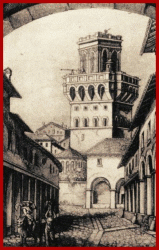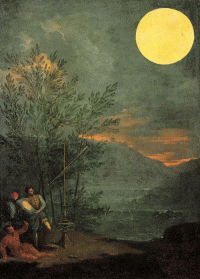Eustachio Manfredi (continued)
In 1702, Marsili put Manfredi in charge of the construction of an observatory in his own house but he later donated his instruments and his collections to the Bologna Senate and, in 1714, the new Science Insitute was officially opened in Palazzo Poggi, now home to Bologna University.
Under Manfredi’s guidance, an impressive astronomy tower was erected at the Institute.
|
|
Fig. 1: View
of the Observatory from San Sigismondo Alley – detail from an engraving by Basoli, 1824. (Credit: Observatory Museum, Bologna University) |
During all these years, Manfredi had
continued to study astronomy.
He worked on observations of the Sun and was the first to notice that there were
considerably fewer sun spots than had been observed in previous decades. This phenomenon
of solar activity is called the "Maunder
minimum", after the astronomer who realised its importance only two centuries later.
| Fig. 2: One of the
paintings by Donato Creti, presented as a gift by Marsili to Clement XI. The paintings, completed
under the guidance of Manfredi, depict the instruments of the Observatory and the observations
of celestial objects. (Credit: Vatican Galleries, Rome) |
|
In an important work entitled De gnomone meridiano Bononiensi ad Divi Petronii, Manfredi put together a history and a description of the great San Petronio meridian created by Cassini, as well as all the observations carried out from the time the instrument began operating in 1655.
From an analysis of almost 80 years of observations, there emerged a gradual reduction of less than one second per year in the obliqueness of the ecliptic. So, for the first time, a process was detected and measured which, if unchanged, will abolish the seasons in about 200,000 years’ time.
|
|


